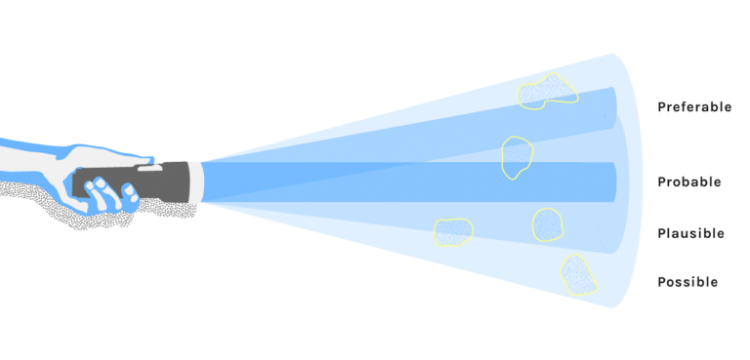Using futures thinking in the Near Future Teaching project
Hi, we have been supporting the Near Future Teaching core team recently on parts of this project. We haven’t yet posted, so here is a short introduction:
We are part of Andthen, a small design strategy consultancy company based in Glasgow, that marries design research with futures thinking to help organisations of all shapes and sizes with early stage innovation. We are working on this project over the next few months to offer some expertise of using a futures-driven approach in strategic planning, and will be posting here about our process and thinking.
— Zoë Prosser and Santini Basra
An intro to futures thinking
While futures thinking is by no means a young practice, it is not particularly defined or established as a discipline; there are few recognised futures thinking degrees, and there is varied understanding of what constitutes a ‘futurist.’ The terms ‘foresight,’ ‘futurism,’ ‘futurology,’ ‘anticipation studies,’ ‘futures thinking,’ and sometimes ‘futures’ for short, are often used interchangeably. While some are slightly varied within their definitions, they all essentially describe the practice of thinking in a structured way about the future, and the methods and approaches that are used to do so. For simplicity, we will just use the term ‘futures thinking’ to describe the practice in this post.
While, as mentioned, futures thinking is a somewhat nebulous discipline, there are characteristics of the practice that are commonly agreed upon:
You can’t know the future
The first and most central tenet of futures thinking is that it is not concerned with prediction; practitioners agree that ‘you can’t know the future.’ Instead, it is about anticipation and exploration. Futures thinking seeks to unpack the question ‘what could happen?’ over attempting to answer ‘what will happen?’

To move past prediction, futures research looks beyond the scope of ‘probable futures,’ to explore the full realm of ‘possible futures’ (see Fig.1.), and in doing so uncovers a suite of unforeseen opportunities and risks. Ultimately, a futures thinking project may have an emphasis on defining which futures are ‘preferable,’ however this is challenging as different groups of people or organisations are likely to have different opinions about what is preferable.
Systemic factors over everyday occurrences
The second tenet is that futures thinking is primarily concerned with systemic factors (and thus has significant crossover with systems thinking), and less so with immediate problems. It recognises that everything is interconnected, and that in order to make meaningful and long-lasting impact, one must understand and intervene in the overall system, rather than simply addressing individual elements.
Not outcome oriented
Futures thinking is not about considering an outcome, or the specifics of a solution. Instead, its divergent, explorative focus intends to give clues or provide information as to where and why something needs to change.
Balancing the empirical with the intuitive
Futures thinking uses a balance of empirical research and intuitive extrapolation to create visions of change that are not only provocative, but also well informed and specific to the contexts which they indent to impact.
Andthen’s Approach
At Andthen, our foundations are rooted in design and strategy; we embrace futures thinking as an approach and a mindset while working in a design strategy space. The effect of this is that we are much more outcome-oriented than the average futures thinker. Futures thinking is a great way to explore and foster critical discussion, but we believe this should be complimented with rigorous analytical mindsets in order to convert exploration and discussion into action. We therefore practice an outcome-oriented approach to futures thinking, and explore futures as a way of understanding what is happening now, and what we should do about it.
Through the exploration of possible futures, we help organisations realise where they want to go and how they want to develop. We foster an understanding of what positive change means to those we work with and create visions to succinctly communicate this.
By leveraging these visions, it becomes easier for organisations to proactively shape change, and create the conditions for their preferred futures to flourish.
Our approach at Andthen combines an explorative futures thinking mindset with a design-led strategic one, from which we focus on defining the actions that are required to move organisations towards their preferred futures.
However, ultimately we see futures thinking as a mindset, which exists beyond any one project or initiative. Our core mission is to encourage a mindset that is constantly interrogating and critically thinking about change. This mindset will routinely challenge organisational ‘myopia’ (short-sightedness), and will contribute to an expanding understanding of various contexts and environments; one that considers seemingly unrelated systemic social, political, technological and economic issues as source material to drive constructive innovation.
Getting back to Near Future Teaching
Within this project, we have an opportunity to use futures thinking to analyse the rich insights that emerged from the Near Future Teaching community scoping (as evidenced in the vox pop interviews and workshops conducted in the early phases project). With reference to external systemic drivers of change in education, society, science and technology (captured in two reviews — Future teaching trends: science and technology; Future teaching trends: society and education), this futures thinking methodology is being used to investigate the values of staff and students within the University of Edinburgh.
We will look to explore various possibilities for futures of digital education at the University, and in doing so define its best course of action to uphold staff and student values in the face of rapid change.
